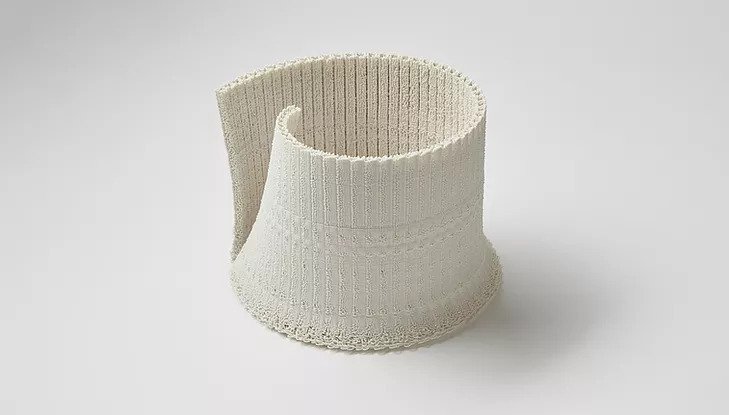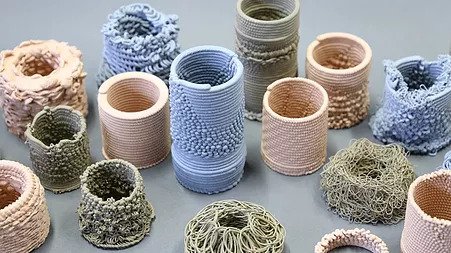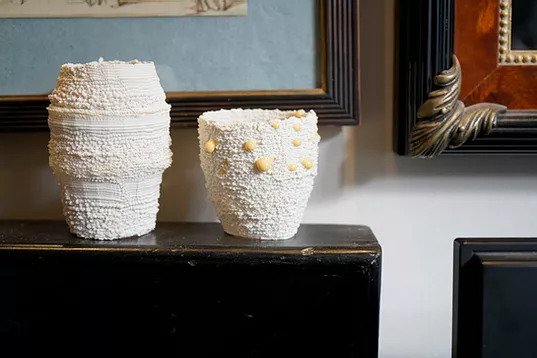Intricate 3D printed porcelain sculptures created by Maltese ceramic artist Nico Conti have been turning heads at this year’s virtual Collect art fair.
Founded by the UK-based national art charity, the Crafts Council, Collect is an international art fair for contemporary craft and design that has been underway on Artsy.net since February 26, with the showcased works available for sale until March 24.
To create his unique structures, Conti blends computer design and 3D printing with inspiration from classical ceramics, architecture, and nature, in order to purvey elements of “distortion, collapse, and ruin.”

3D printing lace-like patterns
Conti’s work with 3D printed porcelain objects came to Crafts’ attention after he graduated from the Royal College of Art in 2019. In contrast to machine-made objects or the uniformity commonly observed within classical art, Conti combined porcelain objects with 3D printed lace-like patterns, using glitches in the printing process to create flaws and unique extrusions on his structures’ surfaces.
Representing Conti at the Collect art fair is Fergus Downey of Alveston Fine Arts, who described Conti’s work to Craft magazine as a “dance of contradictions” that is both fragile yet strong, and modern but also takes influence from the history of pottery.
Conti is showcasing traditional porcelain vessel forms that are influenced by classical ceramics, architecture, and nature, however he has added a distinct sense of distortion to his pieces by incorporating the 3D printed lace patterns to their surfaces.
Having experimented with integrating 3D printing into his vessels and mastering his technique, Conti will look to create larger and more elaborate sculptural pieces in the future in order to continue pushing the boundaries of merging decorative and sculptural 3D printing with traditional materials and concepts.

In addition to experimenting with 3D printed porcelain, Conti has also explored the effect of 3D printed stoneware stained with black iron oxide in his Black on Black collection. He has also printed a wide variety of stained clay vessels and sculptures using a range of shapes, sizes, and colors in his Miscellany Series.
Conti’s full porcelain showcase can be viewed online and is available for purchase until March 24, while his complete collection of projects can be viewed on his website.

Merging 3D printing with art
3D printing technologies and design software have been previously deployed to bring something different to traditional art forms such as pottery and sculpting. Back in 2017, activist, techno musician and software developer Chris Korda developed the PotterDraw program – an open-source software for designing complex and colorful vases that can be optimized for 3D printing.
In 2019, the Centre for Fine Print Research (CFPR) at the University of the West of England Bristol (UWE Bristol) received a £7.7 million grant for projects involving ceramic 3D printing for the recreation of historical artifacts, while elsewhere NVision, a Texas-based 3D scanner manufacturer, collaborated with the Nasher Sculpture Center in Dallas 3D printed replicas of historical sculptures for the visually impaired.
3D printing has also broken boundaries in the fashion world. Fashion designer and researcher Mingjing Lin has explored the application of 3D printing techniques within fashion and textiles for some time, and has investigated how 3D printed materials can achieve fluidity in design and performance while also blending elements of tradition and modernity.

Subscribe to the 3D Printing Industry newsletter for the latest news in additive manufacturing. You can also stay connected by following us on Twitter and liking us on Facebook.
Looking for a career in additive manufacturing? Visit 3D Printing Jobs for a selection of roles in the industry.
Featured image shows Nico Conti’s Of Aurelian 3D printed porcelain, glaze, and gold lustre. Photo via Nico Conti.


